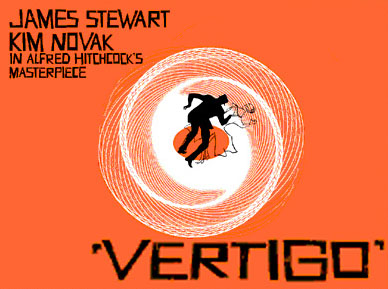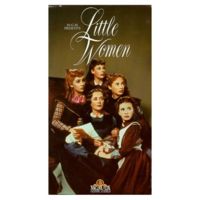Although not received well by critics at its original release in 1958, Vertigo has since become considered one of Alfred Hitchcock’s greatest masterpieces. Vertigo’s plot summary is as follows:
“John “Scottie” Ferguson is a retired San Francisco police detective who suffers from acrophobia and Madeleine is the lady who leads him to high places. A wealthy shipbuilder who is an acquaintance from college days approaches Scottie and asks him to follow his beautiful wife, Madeleine. He fears she is going insane, maybe even contemplating suicide, because she believes she is possessed by a dead ancestor. Scottie is skeptical, but agrees after he sees the beautiful Madeleine.” (Summary found on IMDB.com)
This movie is intriguing, mysterious, and captivating. What makes this so? There have been many movies with murder, love, and deceit. Yet, Vertigo is not like the others.
An aspect of Vertigo that fascinated me and that I would like to look into further is the two main characters and what they represent throughout the movie. James Stewart plays the detective Scottie (Stewart’s character says that although his name is John his acquaintances call him Scottie, so I shall do the same) who falls in love with the beautiful and mysterious Madeleine played by Kim Novak. As much as the movie seems to be about Scottie’s love for Madeleine, I am really not sure it is about love at all. Other than Scottie following Madeleine and the fact that Madeleine is beautiful, there is really no other narrative in the movie that shows the two of them truly building a relationship of love. I believe these characters represent the worst emotions all of us have to learn how to cope with and control. Also, this story deals with the fact that once we make decisions, those are final and unchanging – no matter how we might try to believe things can change or be different.
After the opening credit sequence the audience has already been informed from the music that the movie will be haunting and mysterious.
Watch the opening squence here
[kml_flashembed movie="http://www.youtube.com/v/pz46qS38OgM" width="425" height="350" wmode="transparent" /]
From there we see Scottie for the first time and as he and another police man are chasing a “bad guy” we learn that after Scottie falls and is hanging from the roof he is terrified of heights.  He then watches as the other police man falls off the roof and is killed after trying to save Scottie. Since we do not learn how Scottie ever managed to get out of his roof dangling predicament, Hitchcock is reiterating the fact that this movie is focused on Scottie’s mind and what he has to work through mentally, not physically.
He then watches as the other police man falls off the roof and is killed after trying to save Scottie. Since we do not learn how Scottie ever managed to get out of his roof dangling predicament, Hitchcock is reiterating the fact that this movie is focused on Scottie’s mind and what he has to work through mentally, not physically.
The other main character is Madeleine, the wife of an old friend Scottie is investigating. I would like to look at scene where for the first time the audience and Scottie are shown Madeleine. This scene is very different from Scottie’s introduction – there is no action and she is seems to be hypnotic to Scottie and the viewers alike. Madeleine’s husband, Gavin Elster, informs Scottie to come to the restaurant where he and his wife will be dining so that Scottie can know who his wife is. The scene starts with Scottie sitting at a bar and he cranes his next back to look across the room. The camera follows his gaze to the other side of the restaurant. There is no sound other than noises of people conversing and dining. The restaurant is a very luxurious and there is deep red covering on almost every surface (chairs, walls, floors, curtains…etc). The deep color depicts a feeling of lust (not of love). As we follow Scottie’s gaze we are taken to a shot of nearly the entire dining area. The restaurant is very crowded, there are still just normal noises occurring and then subtly there is a break in between some chairs and we are led to her. She is the only woman in the restaurant who is even noticeable as her emerald green shawl drapers her shoulder. The camera stops very briefly as it overlooks the dining room and as the audience sees the lovely figure the camera begins to zoom in on Madeleine and a soft and almost sad music accompanies this movement. We are then shown Scottie back at the bar; he has obviously noted Madeleine and is watching her. He straightens up and watches her as if he is immediately hypnotized and also confused by her. Madeleine gets up from her table and the music gradually begins to get louder as she walks towards Scottie to exit the restaurant. As soon as Madeleine passes through the doorway that leads to Scottie the lighting behind her dims. She walks a few steps forward and pauses behind Scottie and as we look with Scottie we see Madeleine’s profile and the music and the lights both increase significantly in volume and brightness. 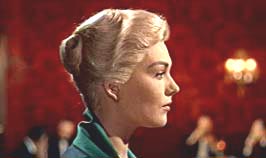 Madeleine then turns her head to look behind her and Scottie turns his face away from her at the same time. Again, as Madeleine turns, the lights dim somewhat. Madeleine leaves the restaurant with Scottie watching her and after she leaves it looks as if Scottie is unsure of what he has just seen. I believe the lighting and music to be very telling in this scene. It displays that Scottie was entranced from Madeleine from the moment he saw her and the surrounding light and music shows how Scottie viewed Madeleine – when she left the room the light left with her and as she pauses and Scottie stares at her profile he sees her illuminated. From the time Scottie saw Madeleine she was a fantasy too him and remained so throughout the movie.
Madeleine then turns her head to look behind her and Scottie turns his face away from her at the same time. Again, as Madeleine turns, the lights dim somewhat. Madeleine leaves the restaurant with Scottie watching her and after she leaves it looks as if Scottie is unsure of what he has just seen. I believe the lighting and music to be very telling in this scene. It displays that Scottie was entranced from Madeleine from the moment he saw her and the surrounding light and music shows how Scottie viewed Madeleine – when she left the room the light left with her and as she pauses and Scottie stares at her profile he sees her illuminated. From the time Scottie saw Madeleine she was a fantasy too him and remained so throughout the movie.
Much happens to Scottie and Madeleine and they find themselves declaring their love for each other. Again, not much has happened that indicates how they really could have fallen in love, but that goes back to the fact that Scottie was always taken by Madeleine as a fantasy. Throughout their short time knowing each other Scottie takes on the role of protector. Madeleine is very troubled and Scottie is willing to do whatever is needed to help her. With no sound reason, Madeleine climbs to the top of a bell tower and jumps. Scottie tried to chase her but due to his vertigo he is unable to reach the top of the stairs in time. Scottie is horrified to see that another person has died due to his vertigo. That’s when it happened…
The focus of intrigue now shifts from the haunted Madeleine to the obsessed and troubled Scottie. Scottie happens to see a woman (Judy 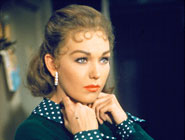 who incidentally is also wearing emerald green the first time she is seen) on the street who reminds him of Madeleine. Scottie and Judy begin seeing each other often and Scottie still obsessed with Madeleine. Judy is aware of this and she states she is in love with Scottie and will do whatever he would so that he would lover her back. Scottie transforms Judy to dress and have her hair exactly as Madeleine had done. After all this, Scottie realizes that Judy really was Madeleine and Scottie take Madeleine back to the bell tower that “Madeleine” jumped to her death from. This is the very last scene of the movie and I will now take a look at how the story accumulates during this final scene.
who incidentally is also wearing emerald green the first time she is seen) on the street who reminds him of Madeleine. Scottie and Judy begin seeing each other often and Scottie still obsessed with Madeleine. Judy is aware of this and she states she is in love with Scottie and will do whatever he would so that he would lover her back. Scottie transforms Judy to dress and have her hair exactly as Madeleine had done. After all this, Scottie realizes that Judy really was Madeleine and Scottie take Madeleine back to the bell tower that “Madeleine” jumped to her death from. This is the very last scene of the movie and I will now take a look at how the story accumulates during this final scene.
As Scottie and Judy enter the Mission Scottie is retelling what happened the day Madeleine killed herself. They both stop and look at the foot of the stairs going up to the bell tower. This shot is very interesting as it is nighttime and nothing appears lit by anything other than the dim moonlight. As we look, we see that the steps are framed in the middle of the screen. Nothing about this scene is inviting and indicates that no good can or will occur here. . Even the long beam up and the rail of the stairs resembles a gallows used for execution by hanging (there is even a trap door at the top of the stairs). Scottie now is forcefully dragging Judy to go up to the top of the bell tower, he says, “One doesn’t often get a second chance. I want to stop being haunted. You’re my second chance Judy. You’re my second chance”. Against her will, he forces Judy up the stairs. They wind up the dark stairs and the music is the most ominous presence. The stairway remains very dark, and the music gets more dramatic with every step taken. Scottie looks down over the ledge of the stairs and is haunted again by his vertigo.
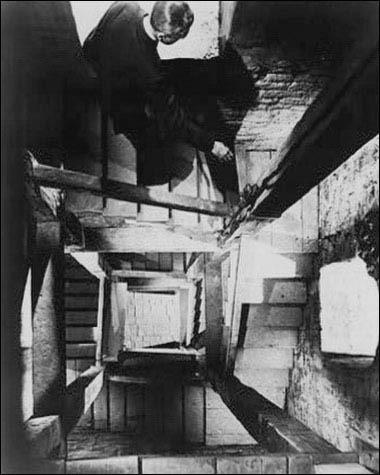
Watch the ascent upstairs
[kml_flashembed movie="http://www.youtube.com/v/fFxNgcrDbVI " width="425" height="350" wmode="transparent" /]
(The technique used to distort the image was first used on this filmed. It is has several names, among them the Hitchcock zoom.)
The shape of the stairs is a daunting spiral which is seen in many forms throughout the movie. I also find it interesting that the camera follows Scottie and Judy up the stairs, as if the audience is forced along with Judy to whatever awaits atop. When they are almost to the top of the stairs the music stops. This is a difference from the intense music that was just accompanying Scottie and Judy. Scottie informs Judy he know she’s Madeleine and the absence of the music assists with the feeling of shock and fear that Judy must be feeling. Judy tries to get away and Scottie forces her back up the stairs. Judy tells Scottie he cannot go up because he is afraid. Scottie repeats his foolish words, “We’ll see. This is my second chance”. Scottie is very angry and forceful at this point. Judy looks very frightened (as would be expected). Once Scottie realizes that he was able to make it to the top, the ominous music loudly begins to play again. Scottie opens the trap door and we see him start to go through. We next see a shot of Judy’s legs and feet motionlessly being dragged up the stairs. It is obvious that she is not willingly going with Scottie, however it is interesting that she is not kicking at fighting. She’s still terribly frightened, but it is as if she is resigned to her fate. In a strange turn, once they are at the top of the bell tower, Judy begins justifying her actions to Scottie and telling him how much she loves him and asks him to keep her safe. This is very interesting considering what has transpired just previous to this. Scottie has forced her to go to the bell tower and she has seemed to fear for her life. I’m not sure how anybody would be so willing to forget those facts so quickly and begin to profess their love. As Scottie replies he seems conflicted, when he tells her, “It’s too late. There’s no bringing her back”. That is quite ironic for somebody who has just been talking about how this is his second chance. Then, just when it seems Scottie and Judy may be able to start over and forgive each other, Judy sees a dark figure emerging from the trap door. It looks eerily like a ghost, or more so like the grim reaper. Frightened, Judy screams and falls to her death – just as Madeleine. The nun that appeared begins to ring the bell, and Scottie (looking over the edge where Judy fell) finally learns that there are no second chances.
Perhaps my favorite aspect of this last scene is the fact that it starts how it began. The first time we see Scottie it is of him falling looking over the edge of a rooftop at the cop who fell to his death. While Scottie doesn’t fall in there very last scene, he is forced to live with the fact that somebody else did suffer a fate that seems so connected to him. 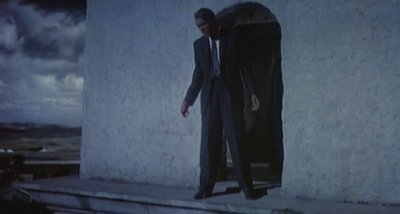
Every scene in this movie is really incredible and I’m sure I could go on forever watching each scene for details and meaning. Hitchcock is brilliant at making each scene have impact on the viewers. Between the music, lighting, and camera placement,  Hitchcock is able to invoke feelings that are strong as well as subtle to viewers. After watching “Vertigo” it truly seemed to me a story not about love but about human emotions and desires. These human emotions are not always rational and humans believe what they want to believe – often with negative consequences. As I stated earlier, Scottie was so infatuated with the fantasy he saw as Madeleine he never had a real or rational love for her. When he lost her he drove himself out of his mind with grief. But was this a normal grief? I think not, I believe it was a grief of obsession. The mysterious creature was gone, he no longer had someone to care for and protect. Even so, when Scottie thought Madeleine was gone his obsession only increased. The change in Scottie was so vivid during the second half of the movie. Scottie had once been so calm and collected, the voice of reason. Now it was Scottie who needed help. If Scottie’s obsession had not have been so great his situation probably would have turned out much differently.
Hitchcock is able to invoke feelings that are strong as well as subtle to viewers. After watching “Vertigo” it truly seemed to me a story not about love but about human emotions and desires. These human emotions are not always rational and humans believe what they want to believe – often with negative consequences. As I stated earlier, Scottie was so infatuated with the fantasy he saw as Madeleine he never had a real or rational love for her. When he lost her he drove himself out of his mind with grief. But was this a normal grief? I think not, I believe it was a grief of obsession. The mysterious creature was gone, he no longer had someone to care for and protect. Even so, when Scottie thought Madeleine was gone his obsession only increased. The change in Scottie was so vivid during the second half of the movie. Scottie had once been so calm and collected, the voice of reason. Now it was Scottie who needed help. If Scottie’s obsession had not have been so great his situation probably would have turned out much differently.
Although I have not yet specifically analyzed gender in this movie, let me expound what I have already discussed and relate it to gender. Hitchcock really plays with the gender roles in “Vertigo”. On one hand they are exactly what you would expect, on the other, he seems to break all of the rules. It is very easy to see Scottie in the traditional “man in charge” and “protector” role, while Madeline is very much a “damsel in distress”. However, there is something disturbing in the way Scottie falls in love with and wants to protect Madeleine. After all, he thought she was crazy when he was first told of her “wanderings”. Laura Mulvey in her essay, “Visual Pleasure and Narrative Cinema” says:
“In Vertigo subjective camera predominates…Scottie’s voyeurism is blatant: he falls in love with a woman he follows and spies on without speaking to…He follows watches and falls in love with a perfect image of female beauty and mystery…Then, in the second part of the film he re-enacts his obsessive involvement with the image he loved to watch secretly. He reconstructs Judy as Madeleine, forces her to conform in every detail to the actual physical appearance of his fetish. Her exhibitionism, her masochism, make her an ideal passive counterpart to Scottie’s active sadistic voyeurism…The Hitchcock here is firmly placed within the symbolic order, in narrative terms. He has all the attributes of the patriarchal super-ego. hence, the spectator, lulled into a false sense of security by the apparent legality of his surrogate, sees through his look and finds himself exposes as complicit, caught in the moral ambiguity of looking.” (FTC 846)
It is interesting that Mulvey notes the audience is lulled into a false sense of security because Scottie has all the attributes of a patriarchal super-ego. Scottie was a lawyer, a police officer, and now a detective. He seems to care about this woman and wants to make sure no harm comes to her. What’s wrong with that? Ah, Hitchcock has used gender norms to confuse us. And (at least for me) he succeeds brilliantly. Scottie gradually seems to be losing control and the audience from the beginning wants to trust him, but it is not until the very end that the audience is able to comprehend Scottie’s madness. In addition, Madeleine/Judy seems to follow the rule for “The erotic woman” as described in Robin Wood’s essay, “Ideology, Genre, Auteur”. The erotic woman is:
“Adventuress, gambling lady…fascinating but dangerous, liable to betray the hero or turn into a black panther” (FTC 719).
These descriptions seem to fit Madeleine/Judy, she certainly is adventuress, and in some sense she did betray Scottie. However, I would not categorize Scottie as a hero. So does that still make Madeleine the erotic woman?
Unfortunately, I decided to write about a movie which we have not watched in class yet. I wish I was able to read and learn the opinions my classmates have on this movie before I had to post this blog. Still, there are several points that I would like to bring in that we have already discussed in class.
I would like to think about Scottie’s sense of reality. Was Madeleine really so amazing? Did he truly love her as he said he did? Amanda talked about reality on her blog titled Reality vs. Perceived Reality . She mentions that people with a mental illness have an altered sense of reality. Just because they may believe something in their mind does not make it a reality. This makes me wonder, does Scottie have a mental illness? He was certainly in a mental hospital. For one thing, I do believe he had an altered sense of reality. His obsession grew so large it consumed all of his thoughts and actions.
First of all, I have to give Charlie a big “thumbs up” for reading different articles/books (mole rats, etc..) and remembering them and relating them to what we talk about in class. Well done. He posted a couple of very interesting blogs along with some cool articles. His post Gender Differences has an excerpt from Norah Vincent who discusses her experiences as she went undercover as a man for 18 months. I have to say that’s very brave of her, I don’t think that sounds like fun at all. Of course since I’m not a man, I cannot relate to her saying that men are taught to have no other emotion than anger. I have a father and two brothers who are really my only long term observations I feel I can comment on. My father is somewhat of a hard headed kind of fellow who doesn’t show emotion a lot. My oldest brother I think is the same in a lot of ways. My other brother (while still stubborn, but then again so am I) breaks the mold somewhat. He is one of those soft teddy bear kind of guys that wants everybody to be happy. While he’s not a blubber head, I’ve seen him cry many times. I couldn’t say the same thing for my oldest brother. My point in bringing this up is; I have two brothers raised by the same mother and father…how can there be such a difference? I suppose in my limited experience I believe that while men aren’t as emotional as women, that does not necessarily make them mean or hard-hearted.
Dan talked about Gender Roles in a recent post and the lack of female-character-driven films. To be honest, I had never really thought about the lack of women driven stories until we talked in class. That proves Dan’s point that we get so accustomed to our mainstream culture we don’t even notice biases. I understand when there are all men casts (such as war films) and that honestly doesn’t bother me. If I’m watching a WWII movie I’m aware of the fact that women weren’t in combat so naturally there will be significantly more male characters. However, there still aren’t (well, perhaps a very few) modern day plots that center on a woman or women. Interesting. I wonder if it’s marketing…if film studios have researched that people would rather spend money on male-character-based movies. I’m not leaning towards that theory though; I think it’s mostly what people are used to. It’s hard to change and even harder to recognize that a change needs to be made in the first place.
Annie gave some very interesting opinions on the book and then the movie version of “Portrait of Jennie” in her blog titled Eben: When Jackasses Fall in Love I was thinking about book to movie adaptations and I can truly say 98% of the time I will say that the book is by far better than the movie. The other 2% (where I actually prefer the movie) is most likely when I’ve watched the movie before reading the book. From reading Annie’s thoughts I assume she watched “Portrait of Jennie” before she read the book. I am somewhat confused myself because I watched the movie some time ago and recently read the book before watching the movie again. I did not like the movie as much as I recall. Perhaps reading the book tainted the movie somewhat for me. But I do agree with Annie that the movie is much more romantic and you feel more emotion for the characters. The book seems to be more about art itself, which explains Eben’s desire for his art more in the book than in the movie.

